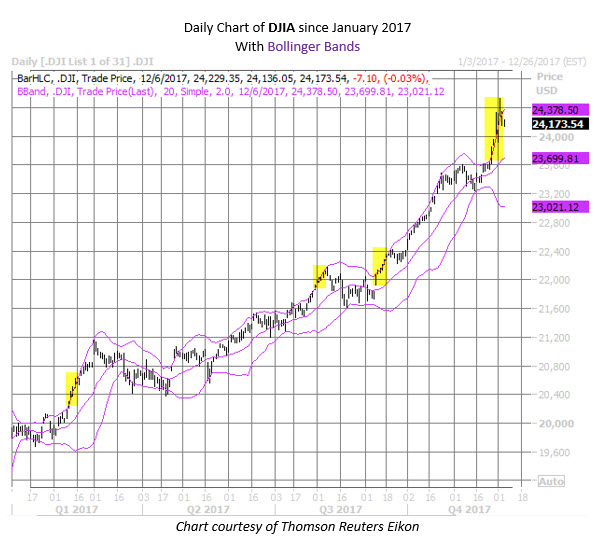The Rare Dow Technical Signal Flashing
On Monday, the Dow Jones Industrial Average (DJIA) ended a fifth straight session above its upper Bollinger Band (BB) -- typically viewed as an overbought signal. The index has since dropped back below this level, due to recent weakness among tech stocks, but that stretchmarked something the Dow has done just a dozen times since 1990. Below, we take a look at blue-chip stock performance after these rare signals, and explain why 2017 is now in the history books.
Breaking Records in 2017
Since 1900, there were just 47 other times when the DJIA went five straight days above its upper BB, the first occurring in 1903, according to Schaeffer's Senior Quantitative Analyst Rocky White. The most recent signal marked the fourth of its kind for 2017 -- the most ever for a calendar year. In fact, there have been just five other years with multiple signals, and all of those years saw just two lengthy stretches above the Dow's upper BB. The last year in which there was more than one signal was 2013, and before that you'd have to go back 50 years, to 1963.

Dow Has Outperformed After Signals
The Dow has performed well after these signals, even though breaking above an upper BB tends to be viewed as an "overbought" indicator. A week after a signal, the DJIA was up an average of 0.88%, and was higher 63.8% of the time. That's compared to an average anytime one-week return of 0.13%, with a win rate of 55.8%, looking at data since 1903.
It's the same story looking all the way out to three months after a signal, at which point the index was up an average of 3.67% -- more than double its average anytime gain. Further, the Dow was in the black nearly 70% of the time three months after a signal, compared to 61.4% anytime.

But Recent Signals Have Preceded Short-Term Weakness
However, looking at more recent returns, it's not nearly as promising. There have been 11 of these signals since 1990, after which the Dow performed in-line or below average. In fact, one month after a signal since 1990, the DJIA was down 0.53%, on average, compared to an average anytime one-month gain of 0.73%. Still, though, the index was in the black 80% of the time three months after recent signals -- a much higher win rate than usual.
